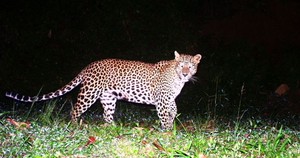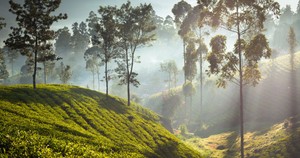- 27 January 2025
Amidst the Tea Where the Leopards Still Roam
As of 2015, Sri Lanka is home to a total of 26 national parks which collectively cover 5,734 km2; almost 9% of our island’s entire area (65,610 km2). While the Department of Wildlife Conservation and the Forest Department of Sri Lanka observe and protect the flora and fauna within these areas, there’s very little support and protection, let alone awareness across the country that doesn’t fall under these perimeters.
As of 2015, Sri Lanka is home to a total of 26 national parks which collectively cover 5,734 km2; almost 9% of our island’s entire area (65,610 km2). While the Department of Wildlife Conservation and the Forest Department of Sri Lanka observe and protect the flora and fauna within these areas, there’s very little support and protection, let alone awareness across the country that doesn’t fall under these perimeters.
The Peak Ridge Forest Corridor (PRFC), an isthmus of sorts between the Mausakelle and Castlereagh Lakes, is part of a key watershed of montane forest. Habitat fragmentation, resulting from centuries of development activities including conversion of these forests into monoculture plantations, have reduced the habitat of the Sri Lankan leopard in these areas.
The Sri Lankan leopard, panthera pardus kotiya, is an endangered subspecies, and data on its status, distribution and abundance in the island’s central hills is lacking and continues to be gathered to date. Studies have been conducted to determine the fundamental aspects of leopard ecology in this highly fragmented wet zone region. Results indicate that leopards inhabit a wide variety of landscapes in the region ranging from large intact forest swaths to small (<5 km2), isolated patches of heavily impacted secondary forest. Long term (minimum six years) use of small patches by individually identified leopards and repeated cub-rearing confirms residency, highlighting the importance of these seemingly marginal lands.
Leopard abundance differs drastically between hill country sites with a higher relative abundance in areas adjacent to large, intact forests than more isolated forest patches. The highland leopards are using a range of landscapes within the region including established and regenerating forests, plantation lands (e.g. pinus, eucalyptus, tea), and areas in close proximity to human settlement.
The Peak Ridge Forest Corridor
Recognising our privilege as caretakers of this magnificent landscape, in 2016, Ceylon Tea Trails and tea plantation companies along the Ridge collaborated in an effort to establish impactful, ‘landscape conservation’ with the technical expertise of the Wilderness and Wildlife Conservation Trust. This effort focused on:
- Protecting existing forest patches as well as replanting activities to protect against forest fragmentation,
- Engaging the communities on the estates to spread awareness among plantation families,
- Engaging school children and involve older children in active conservation and advocacy
- Engaging tourism – Impact and conservation-tourism is a growing segment and a key source of funding for conservation outcomes.
Leopards of the Highlands
Initial research since the inception of this Project in 2016/2017 identified not only high biodiversity in the region but that the leopards in the region use this particular Ridge as a corridor from the greater Peak Wilderness Sanctuary as well as a residential refuge. With the establishment of remote camera traps in the area, a total of four males, five females and their cubs have been identified as the resident leopard population within the Peak Ridge. The work aims to continue with the long-term monitoring of the ranges of ~15 leopards, their lifespan via timelines and recruitment and diet analysis, as well.
The Project moved on to its next phase of establishing a protected area comprising the Peak Ridge Forest Corridor, with the reforestation and restoration of these paramount forest corridors with replantation with native forest species. A key necessity in improving the habitat as well as reducing human-leopard conflict in the region, these corridors will assist the resident leopards to traverse these areas with minimal to no human interaction and allow for improved human-wildlife coexistence. Encroachment of human settlements in the region has resulted in multiple leopard deaths, mostly by humans out of fear for their own lives and also due to poaching, with a majority of these deaths as a result of illegal snares.
While monitoring these leopard populations and reforesting key forest corridors, we work with the partner estates to engage with local communities to create awareness and educate people on the importance of conserving this species. Human-wildlife coexistence and habitat restoration are imperative to protect this vulnerable species. We are optimistic that this project would set the tone for future, multi-partner, landscape conservation efforts in Sri Lanka.
A stay at Ceylon Tea Trails would not be complete without a walk along our nature trails encompassing lush tea landscapes, local settlements and rich cultural heritage. Along these trails lie the hidden gems of flora and fauna, and if you’re lucky enough, a leopard pugmark or some fresh scat – the best indicator that we share these paths with the resident leopards of the Peak Ridge. Guided by our naturalists, get a peek into what a conservationist’s day looks like, walking through our remote camera trails exploring the wilderness of the highlands.
Banner image by Rohan Gunasekara

Extended Stay Savings
Extend your stay for 6+ nights at Cape Weligama, save more and enjoy the holiday of a lifetime.


















